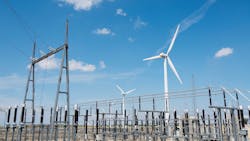Robert E. Kondziolka will be presenting at the 2024 T&D World Live Conference and Exhibition on Tuesday, Oct. 1 at 1:45 p.m. as part of a Super Session on "Delivering the Real Zero Grid." Register here: https://events.tdworld.com/2024/registration.
Customers without electricity for days or weeks? Does that happen in the United States of America in the 21st Century? Increasingly, the answer is yes. It is past time to accept these devasting and life-threatening outcomes and pursue new approaches to resiliency to protect our communities from Black Sky Hazard events.
Electricity is fundamental to the health, safety and economic vitality of our country. It is the fundamental critical infrastructure that must operate for other critical infrastructure to function. Communications, water purification and distribution, wastewater systems, fuels, transportation, medical services, financial systems and physical security do not function during Black Sky events without a resilient electric system.
How can we build a better and more resilient electric grid that serves us when we need it most?
A new approach to improved resiliency needs to be holistic with strong integration amongst traditional and renewable generation resources, transmission, distribution, and end users. In particular, T&D asset owners can start by evaluating the total cost of assets (poles, wires, stations, equipment) that fail during major events. Next, planners and engineers must address long-term system resiliency for individual circuits, corridors, and communities. The economic and social impact to communities needs to be incorporated into the overall assessment. Finally, the industry needs to embark upon a progressive strategic investment program to harden critical elements of the grid, including strategically undergrounding select transmission and distribution lines to ensure continuity of service and quick restoration.
A well planned and built resilient electric system will provide continuity of service to all areas of critical infrastructure as well as targeted and select areas in the community. Improved resiliency does not necessarily require that everything be built bigger and stronger. A resilient electric system may have outages, but the failures will be more predictable, and not lead to total loss of the system and everything it serves. Improved resiliency allows for better triage, better restoration estimates, and rapid responses with faster restoration times.
How can resiliency in urban areas be improved?
One approach is to redefine microgrids so they are built to provide real resiliency to communities. In the past, many have envisioned microgrids as self-sustaining electric islands that can be separated from the grid in times of distress and operate autonomously for extended periods of time with distributed resources. However, conceptual microgrids do not achieve economic and environmental objectives and, therefore, utilities have not incorporated this approach into their resiliency plans.
We need to redefine a microgrid. The microgrid we need should be “reimagined” with the development of electric infrastructure that will provide critical electric service to strategic areas throughout a community during times of greatest distress. This includes targeted hardening and strategic undergrounding of the most critical transmission and distribution lines and upgrading substations to ensure electric service can be provided to other critical infrastructure and areas designated as critical for continuity of communities.
Reimagined microgrids will survive catastrophic events and remain operational. Portions of the system still working will provide electric service to multiple small areas (microgrids) of communities across large service territories.
Imagine if you will a select portion of the grid remaining in service after a wide area catastrophic event. The portions of the system still working provides service to multiple small portions of communities across a large metro area. Homes may be out of power, but potable water is still available. The toilets can be flushed and sanitary systems still operate. Mobile phones still operate and customers still have access to news and emergency information. Phone charging stations are available and a limited number of grocery stores and gas stations still operate. Community centers are available for heating or cooling in extreme weather as well as providing food, water and shelter.
Knowing and having certainty that your community is safe, has access to the basics of life, and that help is on the way allows the community to come together with neighbors helping neighbors.
When considering the costs and benefits of improved resiliency, utilities and regulators must work collaboratively to define the needs for the communities they serve and regulate. Long term plans need to be developed to achieve high levels of resiliency maturity for Black Sky Hazard events. They must identify permanent funding mechanisms to provide certainty to the plans and improvements. One such option can be the development of a small percentage of overall spending specifically dedicated to microgrid resiliency plans. The value of the resiliency improvements should quantify items not normally captured by traditional cost/benefit analysis such as:
- direct cost of losses to homeowners and businesses
- negative impact on life and property
- the immediate and near-term economic impact to the community
- the long-term impact to the economy
- the negative impact to the social fabric of the community.
This new paradigm of planning, design and prudent investment in reimagined microgrids will prepare us for the high impact storms, wildfires, attacks and other events of the future and dramatically reduce the negative impacts on life, property, business, economy and community social fabric.
Robert E. Kondziolka, P.E., is a governing body member of the of the CAISO Western Energy Imbalance Market (EIM) and currently serves as vice chair. This article was originally published in August 2022.
About the Author
Robert Kondziolka
Kondziolka has over 40 years of experience in engineering, planning, budgeting, line routing, public involvement, project management, design, construction, real-time operations, maintenance, reliability standards, and overall management of electrical transmission systems. Presently, Kondziolka is a Governing Body Member of the of the CAISO Western Energy Imbalance Market (EIM) and currently serves as Vice Chair. Prior to becoming an independent Governing Body Member on the EIM, Mr. Kondziolka worked at Salt River Project for 36 years. When he retired from Salt River Project, Mr. Kondziolka held the position of Management Consultant for Grid Resiliency and Security. Previous management positions at Salt River Project included Director of Transmission Line Design, Construction & Maintenance, Director of Power Delivery Engineering, Director of Transmission & Generation Operations, Executive Manager of Transmission Planning and Development, Manager of Transmission Line Design, Project Engineer for the Mead Phoenix Project, and Supervisor for Transmission Line Structural and Geotechnical Engineering. Mr. Kondziolka was a senior engineer at Salt River Project and design engineer at Tucson Electric Power Company addressing all aspects of transmission line design and development. Mr. Kondziolka is a registered Professional Engineer, has been involved in industry organizations, received several awards for research and industry contributions, and authored or co-authored technical articles related to transmission line systems. He has been involved in many of the efforts to achieve a more coordinated and unified Western Interconnection to improve reliability and economics.

